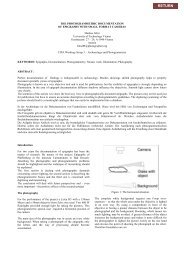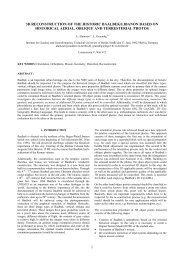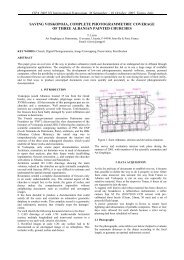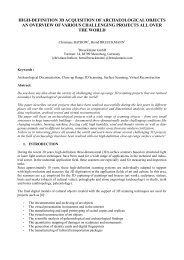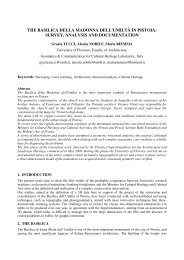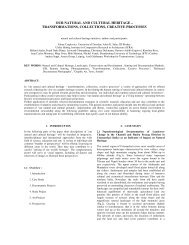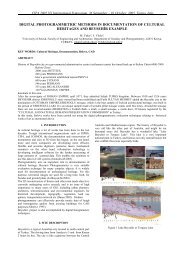CIPA HERITAGE DOCUMENTATION - CIPA - Icomos
CIPA HERITAGE DOCUMENTATION - CIPA - Icomos
CIPA HERITAGE DOCUMENTATION - CIPA - Icomos
Create successful ePaper yourself
Turn your PDF publications into a flip-book with our unique Google optimized e-Paper software.
was not 1cm accurate as it was first expected, it gave the restorers<br />
a precious overview document, (Figure 8). Of course<br />
for the façades and other more usual areas, rigorous orthorectification<br />
was normally used at a reasonable cost.<br />
New products for architects and restorers<br />
Cumulus<br />
Furthermore, even if a huge potential of the dense laser scanning<br />
was assumed since the beginning, no efficient and user<br />
friendly tool was available yet on the market. Yves Egels, at<br />
that time head of the DIAS (photogrammetry department at<br />
the ENSG), already familiar with software development, decided<br />
to write a new one, mainly dedicated to terrestrial 3D laser<br />
Figure 8:<br />
Orthoimage<br />
of the ceilings<br />
of the<br />
Great Mosque<br />
of Sana’a.<br />
data processing. Rapidly operational, Cumulus was able to visualize<br />
laser data using any color, or scanning intensity, or color<br />
from the scanner low resolution camera, or even color from<br />
outer high resolution images whenever georeferenced in the<br />
same topometric system as the laser data. Cumulus was also<br />
able to georeference laser scenes using the spherical target of<br />
the topometric network, to compute sections through the laser<br />
data in any specified direction, and also to compute true<br />
orthoimages, taking into account both occlusions in the laser<br />
data and in georeferenced outer images. Y. Egels made his<br />
software also usable for 3D data captured by traditional stereoplotting,<br />
which, as mentioned above was helpful in producing<br />
orthoimages on the wooden ceilings.<br />
Graphical rendering of the data<br />
Since it became, thanks to Cumulus, rather simple to produce,<br />
among other things, sections and orthoimages, which<br />
are the traditional results that architects and restorers ask for,<br />
some of the people in charge of the restoration operations<br />
asked for more than was initially required, like more cross-sections<br />
(fourteen cross-sections were asked for the Great Mosque<br />
of Sana’a), and horizontal planes at different levels (ground<br />
level of course, but also pillar capital level). The raw output<br />
from Cumulus is unfortunately a bit rough, because of the unexpected<br />
objects which have been scanned together with the<br />
intended objects (the mosques were usually full of bookshelves<br />
which were too cumbersome to move), and also because<br />
of the intrinsic noise of the scanning.<br />
Moreover, there always remain occlusions that produce<br />
holes in the final products. All this makes it inevitable to clean<br />
the raw output from Cumulus, for use by most architects apparently<br />
not prepared to deal with such data. This step has<br />
been very little tried out so far at ENSG, mainly through lack<br />
of time and manpower. However, a student is expected to work<br />
on that specific subject at SFD during the summer 2007, to<br />
produce real cartographic data out of the raw output from Cumulus,<br />
and also to work out its methodology. However, one<br />
may expect that architects will slowly come to appreciate the<br />
very rich content of raw data, in spite of the above mentioned<br />
defects.<br />
Transfer of technology<br />
Yemeni pool of experts<br />
Figure 9: One raw cross-section in the Mosque of Sana’a.<br />
Besides proving to Yemeni authorities the validity of 3D modelling<br />
techniques, Marylène Barret also intended to set up in<br />
arcHItectural PatrImony management In yemen<br />
33



